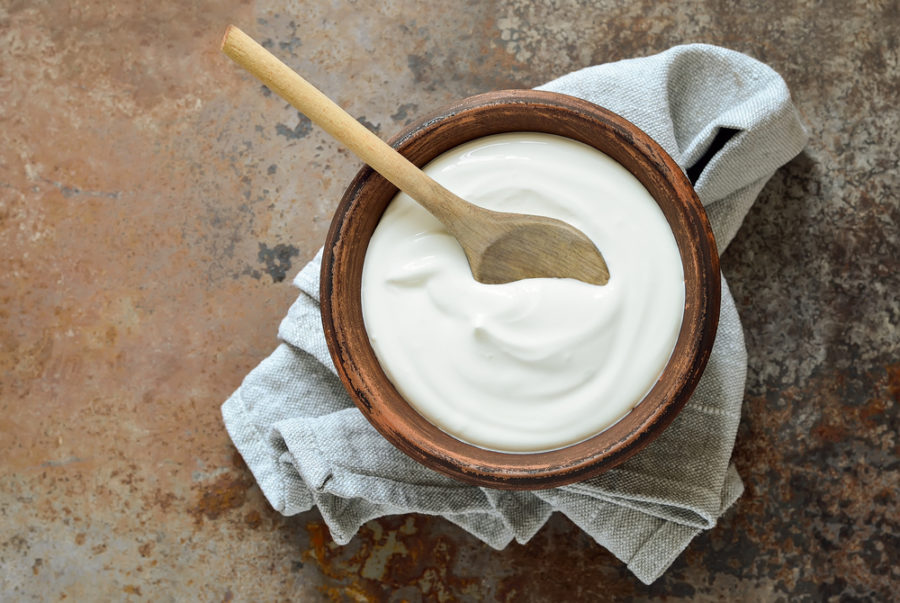The health benefits of yogurt aren’t just for people, so why not share this treat with your pet as well? Most dogs and cats love it, and it makes an excellent addition to their diet.
Yogurt has become a very popular food in recent years, and can be found everywhere, from grocery stores to restaurants. While most mainstream yogurt products are sweetened and flavored, you can still buy plain yogurt, which is the healthiest choice for you – and your dog or cat. Take a look at the health benefits of natural yogurt, and try the recipes on your animal companion.
A short history of yogurt
People have been eating yogurt for thousands of years. Around 6000BC, the Neolithic peoples of Central Asia began milking their animals. Back then, storage containers were made from the stomachs of animals, and the milk naturally curdled and fermented, helped along by the natural enzymes found in the stomachs.
Ancient Ayurvedic writings referred to the health benefits of fermented milk, while Genghis Khan, founder of the Mongol empire, is said to have fed his entire army yogurt, because he believed it instilled bravery in his warriors.
In the early 20th century, Stamen Grigorov, a Bulgarian medical student, was the first to explain the benefits of eating a diet that included yogurt by discovering Bacillus bulgaricus, a lactic acid still used in today’s yogurt cultures. The first yogurt laboratory and factory were opened in France in 1932 — you know it today as Danone Yogurt.
Why is yogurt so healthy?
Adding yogurt to your pet’s diet provides him with a valuable source of protein and calcium, along with magnesium, potassium, vitamin D, K2 enzymes, essential fatty acids and whey. It also contains probiotics to help support the gastrointestinal system and boost immunity.
If your pet has been prescribed antibiotics, the probiotics in a dollop of yogurt can help restore healthy intestinal flora, thanks to strains of good bacteria such as Lactobacillus bulgaricus, Steptococcus thermophiles, Lactobacillus acidophilus, Lactobacillus casei and Bifidus. It’s no wonder that yogurt is considered one of the world’s superfoods!
Just be sure to carefully read labels when buying yogurt, to ensure it contains no artificial colors or flavors, and that no sugar or sugar substitutes have been added, particularly xylitol, which is toxic to pets.
Yogurt offers lots of goodness to your whole family, and can be a beneficial addition to your pet’s daily diet, or as a nutrient-dense treat. Now for the fun part — making your own animal-friendly yogurt recipes!
Alternative milks for yogurt
Goat’s milk
Goat’s milk contains more calcium, vitamin B6, vitamin A, potassium, niacin, copper, folic acid and selenium, than cow’s milk. And unlike cow’s milk, goat’s milk does not contain aggluntinin, so fat globules do not gather together; this makes digestion easier. Goat’s milk also offers more linoleic and arachnodonic essential fatty acids, and a higher proportion of short-chain and medium-chain fatty acids, than cow’s milk. Goat’s milk only contains trace amounts of alpha S-1, an allergenic casein protein, so it’s a great alternative for pets and people who have an intolerance to cow’s milk-based products.
Sheep’s milk
Sheep’s milk is naturally homogenized. It contains vitamins A, B, B1, B6, B12, C, D and E, along with calcium, magnesium, phosphorus and zinc. It also offers ten essential amino acids. Sheep’s milk contains twice the fat of cow’s milk, including Omega 3 and 6 essential fatty acids. It is also rich in medium-chain fatty acids. Its fat globules are small, making them easier to digest, so it’s another fabulous choice for pets and people who have an intolerance to cow’s milk. Those with high lactose intolerance can still eat sheep’s milk products; when yogurt is made from sheep’s milk, the lactose is converted to lactic acid.
Water buffalo’s milk
Also naturally homogenized, water buffalo’s milk is another valuable source of nutrients, including vitamins A, B, B1, B6, B12, C and E, calcium, magnesium, phosphorus and zinc. Like sheep’s milk, it contains ten essential amino acids. It contains no A1 beta-casein, so is another great alternative for pets and people who have an intolerance to cow’s milk. As with sheep’s milk, the fat molecules are smaller, making them easier to digest. Water buffalo are grass-fed, and freely grazing in fields from April through to the fall. At my home on Vancouver Island, water buffalo are part of the “5 Mile Diet”. Their feed is either grown on the farm where they live, or comes from local farmers.
Old-fashioned yogurt
Did you know you can make your own yogurt? This old Eastern European recipe was taught to me many years ago.
Ingredients
1 liter whole milk (e.g. homogenized cow milk or whole naturally homogenized goat milk)
1 small container (175 grams) Balkan style yogurt (you can also use goat milk yogurt, water buffalo yogurt, or sheep yogurt)
Instructions
Choose organic ingredients whenever possible.
Place milk in a large pot and bring to a boil. This is a “watch the pot carefully” recipe. Small bubbles will form around the edges first, then move towards the center. Watch the milk carefully to ensure it doesn’t burn. You can do this by simply turning the heat down just before the milk reaches a rolling boil. Boil the milk for 15 minutes. A timer is helpful for this step.
After 15 minutes, turn the stove off, and let the milk cool down until it is lukewarm.
In a mixing bowl, combine a small amount of yogurt with a small amount of milk until smooth — for example, combine 4 tablespoons of milk and 6 tablespoons of yogurt. The more yogurt used, the firmer the final result will be. A small whisk is perfect for this step.
Put this mixture back in the pot with the rest of the milk. Cover the pot and leave it until yogurt has formed, checking it from time to time. As the yogurt is forming, it looks a bit like Jell-O.
The yogurt can take anywhere from eight to 12 hours to form, though semi-firm yogurt will be ready in as little as four hours if you use whole goat milk. Semi-firm yogurt is perfect for dips, sauces and meal toppers. Whey will come to the top of your homemade yogurt, and it’s good to use too.
Store homemade yogurt in containers and refrigerate or freeze. Homemade yogurt will last as long as commercial brands do.
Fruits, vegetables, herbs and spices can be added to yogurt after the base has been prepared.
Yogurt herb puffs
Ingredients
3 cups whole grain flour (e.g. oat; pseudo-grain flours like hemp and quinoa can also be used)
2 teaspoons baking powder
½ teaspoon baking soda
½ teaspoon sea salt
½ teaspoon ground turmeric
1 tablespoon rubbed oregano; for your feline friends, substitute with dried catnip
1 cup yogurt; for cats, use ¼ cup chopped tuna, salmon or sardines, with ¾ cup yogurt
¼ cup first pressed olive oil
Sprigs of oregano or catnip
Instructions
Preheat oven to 375°F degrees. Baste mini-muffin tins with first pressed olive oil from the ¼ cup you have set aside. Thoroughly combine all ingredients in mixer or blender, or in a medium-sized mixing bowl.
Scoop by tablespoon into mini-muffin tins. A metal or plastic tablespoon works like a charm. Top each puff with a sprig of oregano or catnip for an extra flourish, before popping in the oven. Bake for 15 to 20 minutes. Tops will be golden in color. Cool completely and store in an airtight container or Ziploc bag.
This recipe makes 24 mini-puffs, and can easily be doubled.
You can make biscuits with this recipe too. Simply slice the baked puffs and place on a parchment-covered cookie sheet. Bake in a preheated 275°F degree oven for 45 minutes, until crunchy. Add a “dip” (see below) for an extra special treat.
Cool cat yogurt dips — that that dogs can have too!
Ingredients
Herby herb dip
½ cup fresh herb blend (e.g. dill, mint, oregano, parsley)
½ teaspoon sea salt
1 cup plain homemade yogurt or Balkan style yogurt
2 tablespoons first pressed olive oil or hemp seed oil
OR
Chilly cucumber dip
½ cup plain homemade yogurt or Balkan style yogurt
¼ cup cucumber, peeled and finely grated
1 teaspoon dried dill
½ teaspoon sea salt
Instructions
Combine all ingredients in a food processor or blender, or by hand. For an extra special treat, add ¼ cup chopped fish, like wild salmon or tuna, sardines or mackerel, before serving.








